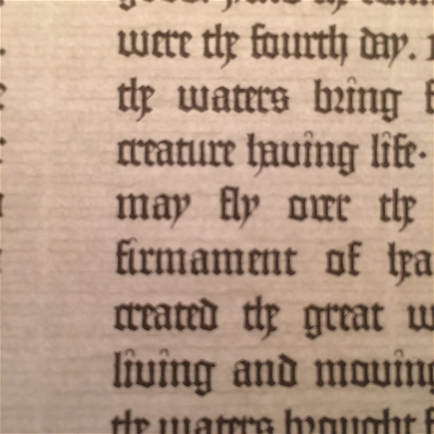 Close up photo of the paper we are using for the 36 line Gutenberg Bible in English Close up photo of the paper we are using for the 36 line Gutenberg Bible in English We have zeroed in on a binder for our 36 line Gutenberg Bible in English. The bidding process for binding the works proved to be interesting. There are not that many binders in the country, and not all binders are ready or willing to sew and bind. Also, not all binders are willing or capable of producing a period binding. Our concern is that as the decades pass, book binding may become a dying art due to the advent of digital books. We ran into a speed bump months back due to one of the prologues in the medieval Bible, which had not yet been translated into English. Interesting that only one had never been translated from Latin into English. We conducted a relentless search for text based documents in a digital format with the prologue, and found them. We then produced side by side renderings of the prologue with the screen shots from the Gutenberg Bible, the text in Latin in modern spelling, and our own translation efforts using Google translate, which performed fairly well in helping us to produce a pretty good draft. We then had our work reviewed by Francesca Colaianni, a neighbor and multi-lingual educator; and then Dr. Robert Brewer, a teacher of classical languages at Georgetown Preparatory School. As serendipity played out, we stumbled upon a moralized Bible with prefaces in the Spanish language produced between 1301 and 1400 at the National Library of Spain. We extracted the prologue in question, which was then reviewed by Mabel Ramirez for the purpose of producing an English translation and then carefully comparing it with our prior efforts. The prologue in question is the long introduction to Paul’s epistle to the Romans. The unknown writer of this prologue sets up a back and forth argument between the Jews and the Gentiles concerning God, the Law of Moses, God’s divine favor, idols, and Christ. The purpose of the prologue is to set up the reader for the text of Paul’s arguments laid out in the epistle. With these aforementioned updates made, we will be conducting a careful review of our finished work in order to make any necessary adjustments prior to printing. Once the final review is done, then we print, sew the signatures, and then turn the text blocks over to the printer for cutting and binding.
0 Comments
|
AuthorPeter Hebert Archives
March 2021
Categories |
 RSS Feed
RSS Feed
